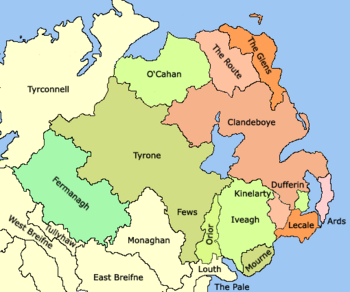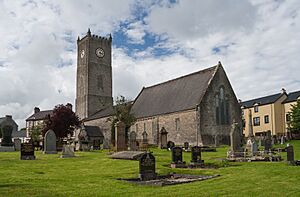Tyrconnell facts for kids
Quick facts for kids
Tyrconnell
Tír Chonaill (Irish)
|
|||||||||
|---|---|---|---|---|---|---|---|---|---|
| 5th century–1607 | |||||||||

Tyrconnell in the early 16th century
|
|||||||||
| Status | Túatha of Ailech (until 1185) | ||||||||
| Capital | Kilmacrennan (royal inaugurations) and Donegal Castle (later seat of O'Donnell dynasty) | ||||||||
| Common languages | Irish | ||||||||
| Government | Elective monarchy | ||||||||
| King / Chief | |||||||||
|
• d. 464
|
Conall Gulban (first) | ||||||||
|
• 1602–1607
|
Rory O'Donnell, 1st Earl of Tyrconnell (last) | ||||||||
| History | |||||||||
|
• Established
|
5th century | ||||||||
|
• Disestablished
|
1607 | ||||||||
|
|||||||||
| Today part of | Ireland | ||||||||
Tyrconnell (Irish: Tír Chonaill, meaning Land of Conall) was an old kingdom in Gaelic Ireland. It is also spelled Tirconnell or Tirconaill. This kingdom was mainly located in what is now County Donegal. For a short time, between 1922 and 1927, County Donegal was even called County Tirconaill.
At its largest, Tyrconnell also included parts of other counties. These were County Fermanagh, County Sligo, County Leitrim, County Tyrone, and County Londonderry. The kingdom was the main home of the Cenél Conaill people. They were a powerful group from the Northern Uí Néill family. Even though the Cenél Conaill ruled, other smaller Gaelic groups lived there too.
Tyrconnell started in the 5th century. At first, it was a smaller part of a bigger kingdom called Ailech. The Cenél Conaill were related to the Cenél nEógain people. Both groups were descendants of a famous leader named Niall of the Nine Hostages. The Cenél Conaill grew stronger as the kingdom of Ulaid (Ulster) became smaller. In the 12th century, the Ailech kingdom split. This is when Cenél Conaill became the independent kingdom of Tír Chonaill. It was ruled by the Ó Domhnaill (O'Donnell) clan. Tyrconnell was a place of many battles, especially during the Nine Years' War (Ireland) in the late 1500s. The kingdom lasted until the 17th century. It then became part of the English-ruled Kingdom of Ireland. This happened after an event called the Flight of the Earls.
Where Was Tyrconnell Located?
Tyrconnell was mostly in the area we now call County Donegal. However, the kingdom was actually larger than just County Donegal. It included parts of County Sligo and County Leitrim in the Republic of Ireland. It also stretched into County Tyrone, County Fermanagh, and the southern part of County Londonderry in Northern Ireland.
Historians like Geoffrey Keating wrote about its size. He said it included areas like Carbury in County Sligo. It also covered Rosclogher in County Leitrim. Magheraboy and Firlurg in County Fermanagh were also part of it. This means Tyrconnell was about the size of countries like Corsica or Lebanon today.
The O'Donnell Rulers
The O'Donnell clan were the main rulers of Tyrconnell. They chose their leader, or Chief, through a system called elective monarchy. This meant the next leader was chosen, not always the oldest son. The O'Donnells were very important in Irish history.
Religion in Tyrconnell
The main religion in Tyrconnell was Catholic Christianity. The area of Tyrconnell was part of the Diocese of Raphoe. This diocese was led by the Bishop of Raphoe and was formed in 1111. It covered most of Tír Conaill.
Christianity was very important to the O'Donnell rulers. Their relative, Colm Cille (also known as St. Columba), was born nearby. He is one of Ireland's three patron saints. The founder of the kingdom, Conall Gulban, was one of the first noblemen to become Christian. He was converted by St. Patrick. The O'Donnells later used the symbol of the cross. Their motto was in hoc signo vinces, which means "in this sign you will conquer."
Learn More
- List of rulers of Tyrconnell
- Annals of the Four Masters
- Short Annals of Tirconaill
- Annla Gearra as Proibhinse Ard Macha



